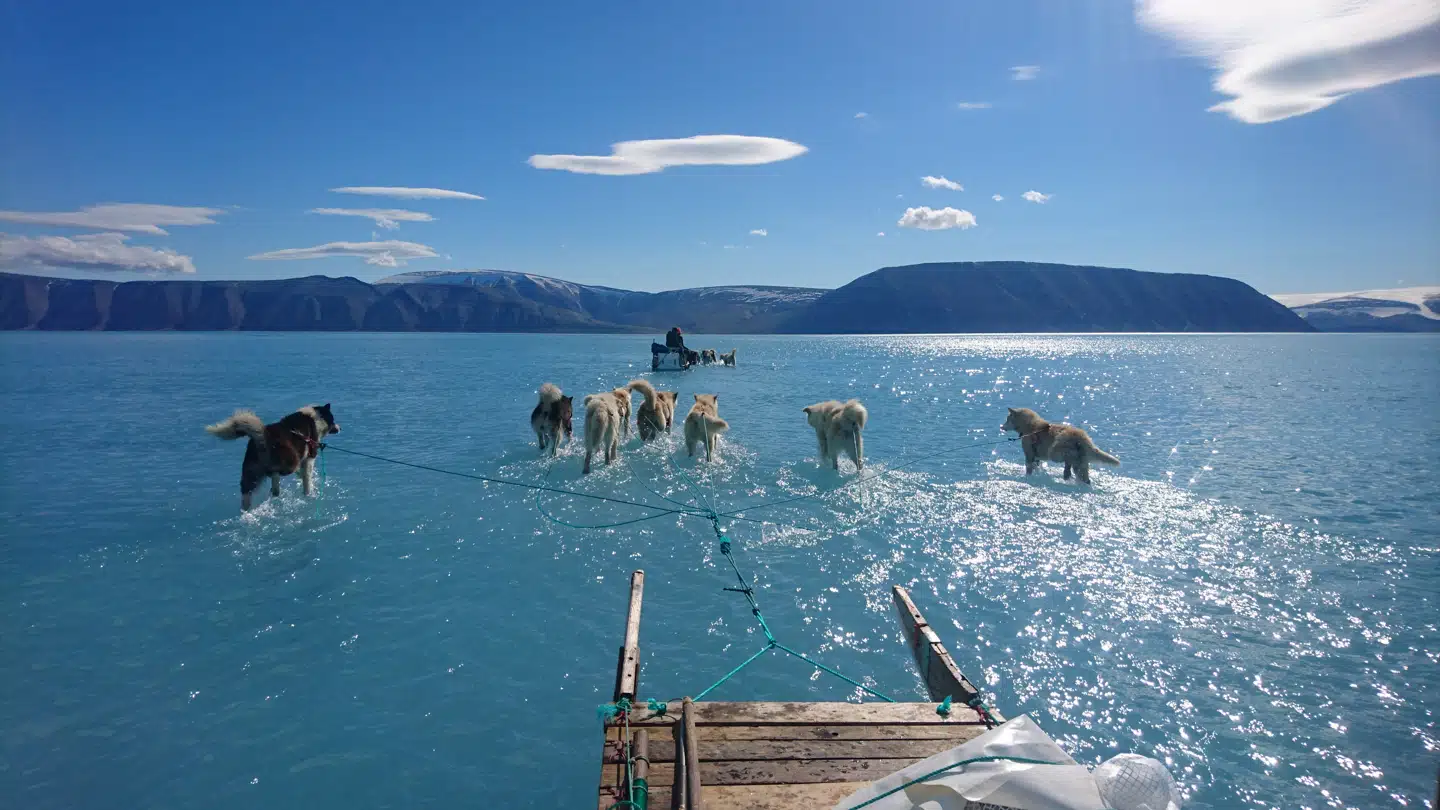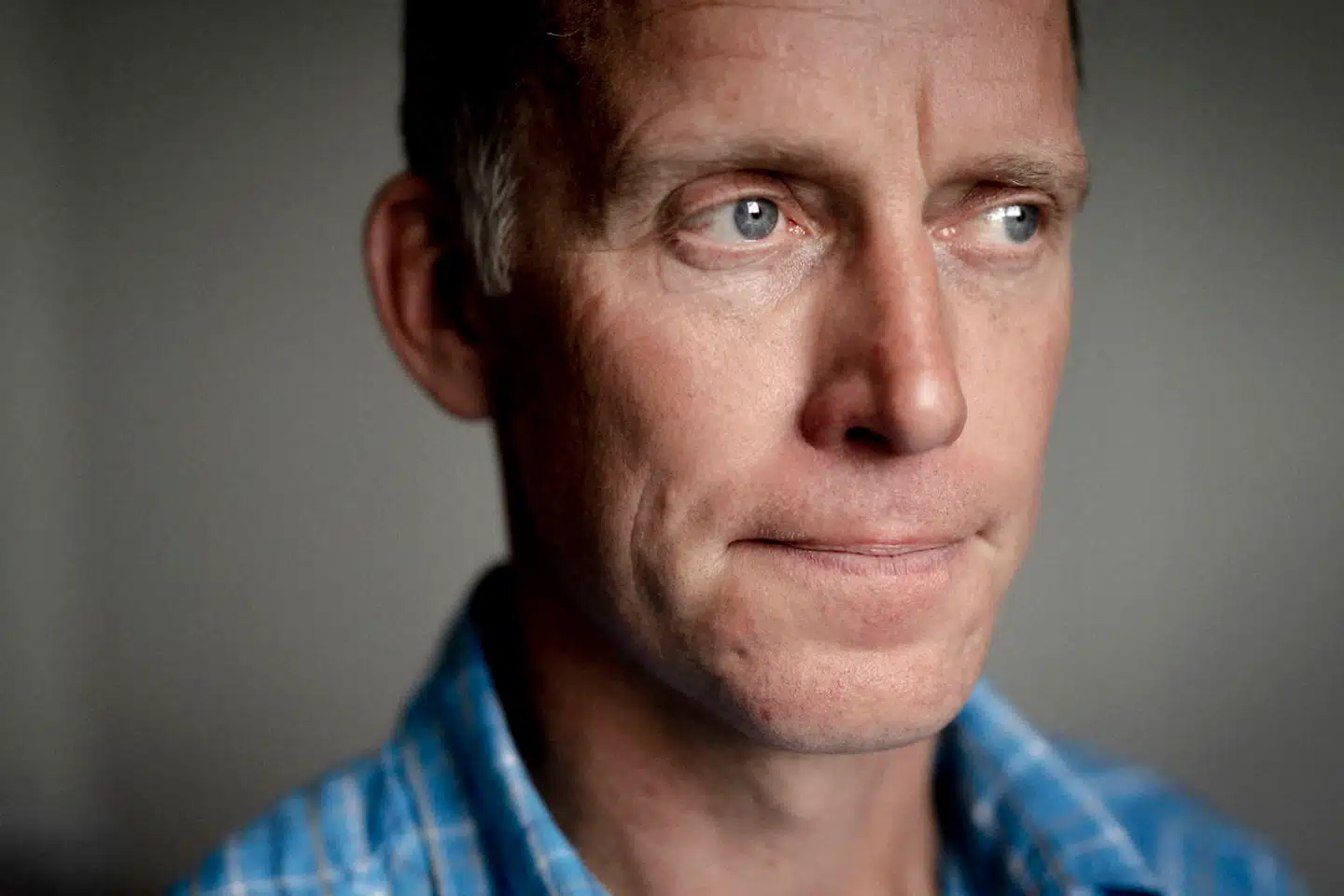Sometimes a picture speaks more than a thousand words. Sometimes the picture merely speaks what the viewer wants to hear. Over the past week, a photo of a dog sled moving through melt water in a fjord near Thule in north-west Greenland went global.
The picture was taken by a scientist at the Danish Meteorological Institute (DMI) and appears ominous. As if the ice is melting fast under the feet of the dogs and might at any moment crack and pull the sled down into the deep water. As if the very foundation of humanity is melting before the camera.
The photo has been shared by CNN, the BBC and several of the world's leading papers, and even the former U.S. Vice President and one-time presidential candidate Al Gore, who joined the fight against climate change in 2001, has asked the DMI for permission to use the picture in his efforts to convince the world that action is urgently needed to prevent a looming climate disaster.
In Denmark, too, politicians have linked the photo to climate change.
Pia Olsen Dyhr, leader of the Socialist People's Party (SF), has used the picture to promote one initial result of ongoing negotiations to form a new Danish government – a 70 percent reduction in CO2 emissions by 2030.
A similar reaction has come from Morten Østergaard, head of the Danish Social Liberal Party (R).
»The photo shows that climate change is rapidly changing our planet. This is what we're up against, guys. Dramatically accelerating climate change affecting our planet and damaging our children's living conditions,« he wrote on Facebook.
But the question is: is that really what the photo shows?
»This always happens,« says Apollo Mathiassen, a hunter and local councillor for the Siumut Party in the municipality of Avannaata.
Sign of a cold winter and thick ice
»This happens particularly up there at Thule where the picture was taken. It just depends on how thick the ice is. This doesn't happen with thin ice. It's because the ice is so thick that there aren't any holes for the water from the melting snow to pass through, so the water gathers on top,« Apollo Mathiassen explains.
In north-west Greenland hunters call this »imaq«, meaning something along the lines of »everything is water«.
»I was probably about five years old when I first saw this in the early 1970s. It's completely normal. Actually, it has become a bit rarer because the climate is warmer now, and if the ice doesn't thicken enough over the winter, the water will push through,« the 51-year-old hunter explains.
In other words – according to him – the picture does not show the impact of climate change but rather a phenomenon that will gradually disappear as our climate warms. If winters get warmer, the ice will be thinner in spring. The melt water will run through cracks in the ice, and dog sleds, dog mushers and dogs will no longer move through melt water, as in the photo, but will face thinner, cracking ice.
In 2017 Apollo Mathiassen posted a video of the same phenomenon, filmed some 700 kilometres further south, on Facebook. He suggests that social media are the reason why the world has suddenly discovered what spring in north-west Greenland looks like and is now interpreting it as a looming disaster.
»These days it's easier to share things on social media, which is what I did with that video in 2017. But the video does not show a disaster, neither does the photo, and it's great that someone wants to write about that and help people understand conditions here in Greenland,« says Apollo Mathiassen – who stresses that, for the sake of good order, he contacted hunters in Qaanaaq – Thule in Greenlandic – to confirm that melted water sitting on top of the ice sheet is also quite common there.
Finn Bo Madsen, head of DTU Space, the department for space research at the Technical University of Denmark (DTU), has set up GPS stations across Greenland and has been visiting the area around Qaanaaq – Thule – since the 1980s. He too does not see anything unusual in the now world-famous photo.
»I've seen it with my own eyes and driving through half a meter of water in spring is widely described in the logs of the old expeditions. So, the photo looks good, but the hunters are right. It doesn't show climate change,« Finn Bo Madsen says.
Abused by alarmists
Jason Box, a professor of glaciology, the science of naturally occurring ice, at the Geological Survey of Denmark and Greenland (GEUS), says he understands why hunters are surprised to see a photo of a common phenomenon in the month of June be misinterpreted as evidence of a climate disaster.
»This photo is being abused by alarmists,« Jason Box says.
»Strictly speaking, the picture doesn't say anything about climate change. It shows a well-known phenomenon which even the polar explorer Knud Rasmussen described in his books. The hunters have an interesting point in making clear that the photo shows melted snow on thick ice, on which it is safe to drive, so actually the photo doesn't show climate change but rather a scenario which may disappear with climate change,« the professor says, drawing a deep breath.
»You need to tread carefully in trying to bring some nuance to these things. On the one hand, you can easily be accused of being a climate sceptic, and on the other hand, a lot of climate deniers stand ready to use the slightest doubt or inaccuracy to denounce human-made climate change,« Jason Box explains.
And so, while alarmists' use of this photo may give climate deniers a reason to shout »fake news«, dramatic climate change is undeniably happening in Greenland. The overall trend is clear. The ice is melting.

What is also true, according the Danish Meteorological Institute (DMI), is that temperatures have been unusually high in Greenland this June. On 12 June the monitoring station at Qaanaaq recorded the highest temperature of the month so far, at 17.3 degrees Celsius, and on the following day, 13 June, when the dog-sled photo was taken, a temperature of 15.2 degrees was recorded.
The average temperature for Qaanaaq in June – as recorded from 2001 to 2013 – is 3.2 degrees Celsius, while the average highest temperature is 5.7 degrees.
Climate change is now occurring particularly fast in north-west Greenland, but Jason Box cautions against interpreting a few unusually warm days in the north west of Greenland as evidence of climate change. Using the same logic, it might then also be argued that 2017 and 2018 were very cold years in Greenland, proving that climate change does not exist. But climate change does exist. It is simply not that easy to show, and it is important to distinguish between weather and climate.
»Greenland is affected by the weather phenomenon we call North Atlantic Oscillation (NAO) which is connected to the weather system of Arctic Oscillation across the North Pole. It's somewhat similar to El Nino in the southern hemisphere and it causes a variation in the weather which makes it hard to tell if individual events are due to climate change or variations in NAO. So, for example, 2017 and 2018 were very cold years in Greenland,« Jason Box says.
»My guess, and that of others, is that climate change must be affecting NAO, but strictly scientifically this is something we need to focus more on,« Jason Box says.
»That's why we are focusing on the overall long-term trends showing that the North Pole is warming faster than the rest of the world and that the ice in Greenland is generally melting. We have been able to demonstrate that for years in graphs and satellite photos, but it doesn't have the same impact as a photograph – even if, strictly speaking, that photograph does not show climate change,« Jason Box says.
DMI explanation ignored
Steffen Malskær Olsen acknowledges all this. The DMI climate scientist took the now famous photo while gathering monitoring equipment placed previously on the ice, and part of his research involves measuring the thickness of the ice.
On 13 June, the ice was 1.2 metres thick, so even with record-high temperatures, the ice was 20 centimetres thicker that at the same time last year.
In short: Yes, warmer temperatures in the area may have accelerated the spring melt – causing water to gather on top of the ice, as shown in the pictures – but at the same time, the ice is 20 centimetres thicker than last year, so the water cannot pass through it.
»It's been really overwhelming to see how that photo has been used. Personally, I actually don't mind the photo being used as an analogy for climate change, but as I wrote earlier on Twitter, how you interpret the picture is »up to you«,« says Steffen Malskær Olsen, who has just returned from Greenland.
»If a researcher can't take a picture of an extreme situation, something must be wrong. Neither I nor DMI can control how that photo is used and shared through social media,« he says.
»But we have been particular about stressing that this is an extreme event due to unseasonably high temperatures which cannot scientifically be evidenced as being caused by climate change. At the same time, we have explained that our model projections do indicate that climate change will bring more of these extreme events. It's a bit like saying that Storm Bodil (which hit Denmark in December 2013, ed.) cannot by itself be explained by climate change, but similarly, scientific models indicate that climate change will lead to more storms like Bodil,« the now world-famous scientist explains.
The Danish Meteorological Institute wrote an accompanying text which was sent with the photo to international media, stating clearly that the photo shows a phenomenon which is caused by warm spring weather in north-west Greenland and not necessarily by climate change:
»Our climate model simulations expect there to be a general decline in the length of the sea ice season around Greenland - how fast and how much is very much dependent on how much global temperature rises – but this week's warming is still a weather-driven extreme event, so it’s hard to pin it down to climate change alone,« the DMI writes.
Still, the image has triggered headlines such as this one: »'This Should Scare the Hell Out of You': Photo of Greenland Sled Dog Teams Walking on Melted Water Goes Viral«. And CNN presented the photo with the following words:
»The devastating impact of a warming planet has been captured in a stunning image of sled dogs walking on Greenland's melting ice sheet.«

A doomsday story
Jørgen Peder Steffenson, a professor of glaciology at the University of Copenhagen, has spent his summers in north-west Greenland since the early 1980s and is clearly frustrated with the way the photo is being used.
»It's a great photo, but the situation is completely normal. In itself, the picture is pretty innocent, but it's being abused. It's like a nude photo being shared online,« Jørgen Peder Steffensen says.
»The world is so caught up in getting the next doomsday story that anything goes, and so climate activists are pulling out one circus horse after another. Here we have a photo of an annually occurring phenomenon around Qaanaaq in Greenland,« he says.
»We have an entire movement which has mounted a little Swedish girl in front of the climate wagon, and she (Greta Thunberg, ed.) has been fed with fear and doomsday stories through all of her childhood. To us scientists it's inherently frustrating that everything is exaggerated and presented as doomsday stories, but these doomsday stories are also radicalising our youths,« the professor states. He is quick to add with prudence:
»It's difficult to say this without being accused of being a climate denier. I am not. Climate change is real, and I am personally glad that our incoming government is taking the climate seriously. But we need to be careful about the doomsday stories, and we should not panic about a dog sled running through water,« Jørgen Peder Steffensen says.
Translation: Bibi Christensen

